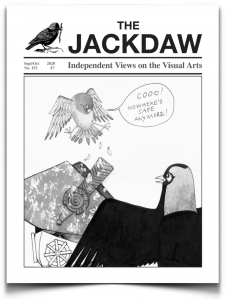 Advocating life drawing at art school is a deeply conservative and reactionary position. Arguments in favour of life drawing usually fall into one of two camps (or sometimes both). I am utterly unconvinced by both.
Advocating life drawing at art school is a deeply conservative and reactionary position. Arguments in favour of life drawing usually fall into one of two camps (or sometimes both). I am utterly unconvinced by both.
The first, and weaker, argument contends that it is necessary to learn the rules before you can break them. This is an authoritarian position where you must learn to draw “properly” before you can make other kinds of art. We can almost dismiss this argument out of hand. Imagine discovering a great artist, falling in love with her work, telling others how wonderful it is, but then finding out that her life drawing wasn’t up to much. Would you re-assess your judgement and decide that the art you once loved must be substandard? You probably wouldn’t dismiss your favourite musician if you discovered that he couldn’t read music: this is irrelevant if the music is good. Perhaps cinema might be a better comparison, since artists also work in film. Most people wouldn’t rubbish their favourite director upon finding out that he couldn’t draw very well. So why would you apply this criterion to an artist film maker? In both cases it is irrelevant if the films are good.
This first argument shifts the focus away from the artwork and onto the artist’s training. To accept the argument is to accept that you are unable to judge the quality of the artwork without knowing something about the artist’s education. This is a useful argument if you do not like Modern or contemporary art, where such training is not discernible. Under this perspective, Mondrian’s grid paintings or Rothko’s colour fields are acceptable only if they can first prove that they are able to make more conservative kinds of art. This is the concession to Modern and contemporary art that the conservative authoritarian makes, reminding us that Picasso was an excellent draftsman before he dedicated his life to learning to draw like a child. If you value any kind of non-representational art (such as abstraction), any kind of de-skilled art, performance or relational art, then the argument that the prior mastery of life drawing is necessary falls short.
The second, and more sophisticated, argument claims that mastery of life drawing is not necessary, but that it should be learnt anyway. Even if, after hours of classes, the art student is useless at drawing the figure, and even if she has no intention of making any kind of figurative drawing, painting or sculpture, there are still fundamental benefits to studying life drawing. These benefits include discipline (turning up on time, prepared with the necessary equipment), concentration (the ability to work on one thing for extended periods) and looking (training the eye). Proponents of this argument contend that these skills are just as useful for making non-representational and deskilled practices, because they provide the student with a greater sense of aesthetic awareness and a robust work ethic. But I have never once heard anyone who has made this argument call for the reintroduction of still life classes. Imagine bragging that your fine art degree programme obliges students to spend one day a week drawing fruit to enhance their concentration and observational ability. Why not also teach geometry, perspective and colour theory on a weekly, compulsory basis? You could do this, but you would have a deeply reactionary course that would churn out conservative artists. Readers might note that this second argument is also an authoritarian one, since it assumes that all art students learn in the same way. Whatever the student’s learning style, background (religious sensibilities come to the fore here) and whatever their artistic aims, their training must be grounded in observation of the nude human figure.
Another strand to the second argument maintains that life drawing can be taught in an experimental manner to produce more cutting-edge artists. Examples include where life drawing concentrates on experiential drawing or experimentation with materials, methods and techniques (there are other examples). But this is no longer life drawing, for to teach these things there is no need for a model. Terming it as such only reinforces the assumption that the underlying tradition of life drawing is something that must be preserved, even when it is irrelevant to the tutor’s pedagogic aims and the student’s artistic ambitions.
Life drawing was developed as a pedagogical tool to train Western artists to make figurative painting and sculpture. The reason that it still exists in some art schools is mostly down to tradition. While life drawing may be useful for some types of artist, it is not applicable to all. I am not saying that its teaching necessarily prohibits the development of good, exciting and relevant artists. My argument is that it is not necessary and does more to hinder the development of such artists than it does to encourage them. To teach it is to enforce a hierarchy: representation over abstraction, traditional forms of art over more avant-garde kinds. It is also to deny art’s radical potential: must art activists first learn such conservative lessons? Embedded within this hierarchical and authoritarian position lies a reactionary and conservative politics. Nostalgia and fascism have always walked hand in hand. Think of Mussolini harking back to the Roman Empire, or Hitler’s love of classical art and architecture. Today we might think of Trump’s slogan “make America great again” and Brexit talk of “taking back control”. We urgently need free thinking artists able to critique contemporary nostalgia, populism and even outright racism and sexism. For that we need a pedagogical approach that is progressive, inclusive, and libertarian. This will allow for more progressive forms of art to develop and emerge – including non-Western kinds. For these reasons, I am against the teaching of life drawing.
Martin Lang is a lecturer in Fine Art at the University of Lincoln.
E-mail: mlang@lincoln.ac.uk



Martin Lang: Against life drawing
The first, and weaker, argument contends that it is necessary to learn the rules before you can break them. This is an authoritarian position where you must learn to draw “properly” before you can make other kinds of art. We can almost dismiss this argument out of hand. Imagine discovering a great artist, falling in love with her work, telling others how wonderful it is, but then finding out that her life drawing wasn’t up to much. Would you re-assess your judgement and decide that the art you once loved must be substandard? You probably wouldn’t dismiss your favourite musician if you discovered that he couldn’t read music: this is irrelevant if the music is good. Perhaps cinema might be a better comparison, since artists also work in film. Most people wouldn’t rubbish their favourite director upon finding out that he couldn’t draw very well. So why would you apply this criterion to an artist film maker? In both cases it is irrelevant if the films are good.
This first argument shifts the focus away from the artwork and onto the artist’s training. To accept the argument is to accept that you are unable to judge the quality of the artwork without knowing something about the artist’s education. This is a useful argument if you do not like Modern or contemporary art, where such training is not discernible. Under this perspective, Mondrian’s grid paintings or Rothko’s colour fields are acceptable only if they can first prove that they are able to make more conservative kinds of art. This is the concession to Modern and contemporary art that the conservative authoritarian makes, reminding us that Picasso was an excellent draftsman before he dedicated his life to learning to draw like a child. If you value any kind of non-representational art (such as abstraction), any kind of de-skilled art, performance or relational art, then the argument that the prior mastery of life drawing is necessary falls short.
The second, and more sophisticated, argument claims that mastery of life drawing is not necessary, but that it should be learnt anyway. Even if, after hours of classes, the art student is useless at drawing the figure, and even if she has no intention of making any kind of figurative drawing, painting or sculpture, there are still fundamental benefits to studying life drawing. These benefits include discipline (turning up on time, prepared with the necessary equipment), concentration (the ability to work on one thing for extended periods) and looking (training the eye). Proponents of this argument contend that these skills are just as useful for making non-representational and deskilled practices, because they provide the student with a greater sense of aesthetic awareness and a robust work ethic. But I have never once heard anyone who has made this argument call for the reintroduction of still life classes. Imagine bragging that your fine art degree programme obliges students to spend one day a week drawing fruit to enhance their concentration and observational ability. Why not also teach geometry, perspective and colour theory on a weekly, compulsory basis? You could do this, but you would have a deeply reactionary course that would churn out conservative artists. Readers might note that this second argument is also an authoritarian one, since it assumes that all art students learn in the same way. Whatever the student’s learning style, background (religious sensibilities come to the fore here) and whatever their artistic aims, their training must be grounded in observation of the nude human figure.
Another strand to the second argument maintains that life drawing can be taught in an experimental manner to produce more cutting-edge artists. Examples include where life drawing concentrates on experiential drawing or experimentation with materials, methods and techniques (there are other examples). But this is no longer life drawing, for to teach these things there is no need for a model. Terming it as such only reinforces the assumption that the underlying tradition of life drawing is something that must be preserved, even when it is irrelevant to the tutor’s pedagogic aims and the student’s artistic ambitions.
Life drawing was developed as a pedagogical tool to train Western artists to make figurative painting and sculpture. The reason that it still exists in some art schools is mostly down to tradition. While life drawing may be useful for some types of artist, it is not applicable to all. I am not saying that its teaching necessarily prohibits the development of good, exciting and relevant artists. My argument is that it is not necessary and does more to hinder the development of such artists than it does to encourage them. To teach it is to enforce a hierarchy: representation over abstraction, traditional forms of art over more avant-garde kinds. It is also to deny art’s radical potential: must art activists first learn such conservative lessons? Embedded within this hierarchical and authoritarian position lies a reactionary and conservative politics. Nostalgia and fascism have always walked hand in hand. Think of Mussolini harking back to the Roman Empire, or Hitler’s love of classical art and architecture. Today we might think of Trump’s slogan “make America great again” and Brexit talk of “taking back control”. We urgently need free thinking artists able to critique contemporary nostalgia, populism and even outright racism and sexism. For that we need a pedagogical approach that is progressive, inclusive, and libertarian. This will allow for more progressive forms of art to develop and emerge – including non-Western kinds. For these reasons, I am against the teaching of life drawing.
Martin Lang is a lecturer in Fine Art at the University of Lincoln.
E-mail: mlang@lincoln.ac.uk
Share: